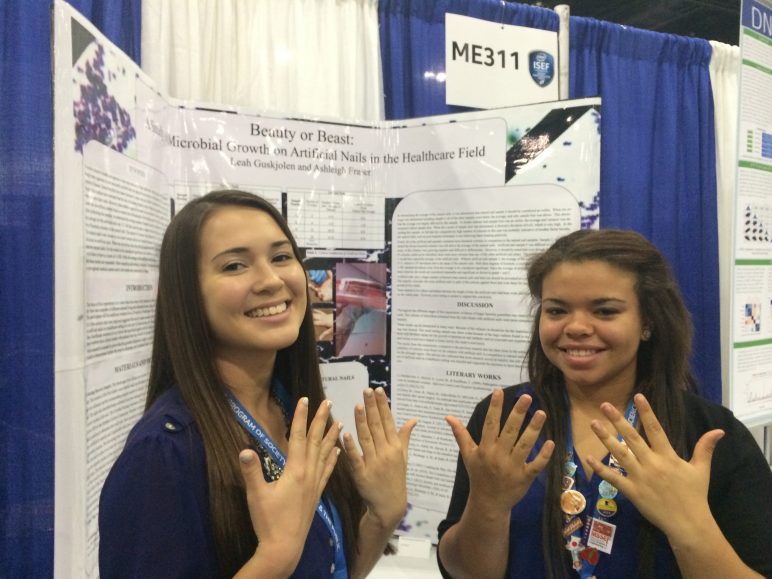Beautiful nails may harbor germs

Leah Guskjolen (left) and Ashleigh Fraser (right) show off their nails at their poster on germs that live on fingernails.
B. Brookshire/SSP
LOS ANGELES – The best scientists want to know why. Ashleigh Fraser and Leah Guskjolen, both 18, wondered why they would not be allowed to wear nail polish or artificial nails during their training to become Certified Nursing Assistants. But when they asked, the only response they got was that “rules are rules.” Not satisfied, the teens decided to probe the issue themselves. Their study of nurses showed that beautifully painted nails can harbor some nasty bacteria.
The teens presented their findings at last week’s International Science and Engineering Fair, or ISEF. Created by Society for Science & the Public and sponsored by Intel, the annual competition brings together young scientists from around the world to show off their projects. (SSP also publishes Science News for Students and this blog).
For their new study, Ashleigh and Leah, seniors at Willcox High School in Willcox, Ariz., borrowed materials from the hospital where they had trained as nursing assistants. Ten nurses there agreed to give them little scrapings off the top side of their nails. Half of the participants had natural nails. The other half wore nail polish or fake nails on top of their natural nails. The teens grew bacteria from the scrapings on agar plates; these are plastic dishes with a gel that feeds bacterial growth.
Natural nails produced an average of 4.3 bacterial colonies. In contrast, scrapings from nail polish or artificial nails produced an average of 17.5 colonies! Leah and Ashleigh had their answer. Only natural nails are allowed because polished or artificial nails tend to harbor far more bacteria. The germs could be dangerous to sick patients.
Leah notes that they are not the first scientists to look at nails in a medical setting. Still, she says, “It’s something that should be taken much more seriously than it is.” To emphasize that, she points to the large list of similar studies she and Ashleigh uncovered during their research.
When nurses touch patients, they often wear gloves, but many small tasks are performed bare-handed. The teens hope to raise awareness of how dangerous artificial nails can be in the medical setting. “What shocked me,” Leah says, “is how unconcerned some of the nurses were. They didn’t think their nails were dangerous.” Ashleigh agrees and observed that to preserve their pricey manicures, nurses with polish or fake nails tended to scrub less vigorously when washing their hands. Their nails might look nice, but this lax handwashing habit might contribute to the large numbers of germs that hang onto their nails.
Ashleigh has never really liked nail polish, so she won’t have to change much to pursue her dream of being a surgeon. But the results have prompted Leah, who wants to be a nurse, to give up her artificial nails for good. “They are very pretty,” she says, “I love them.” But now that she knows the risks they can pose, she concedes that for a health professional they just are “not worth it.”
Follow Eureka! Lab on Twitter
Power Words
agar A gelatinous material made from certain marine algae used as a material (and food source) in which to grow bacteria.
bacterium (plural bacteria) A single-celled organism forming one of the three domains of life. These dwell nearly everywhere on Earth, from the bottom of the sea to inside animals.







